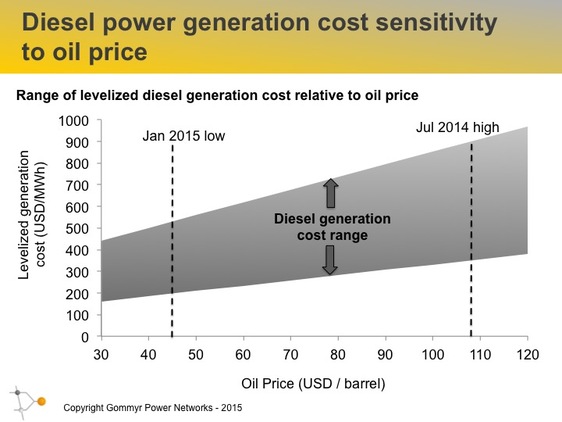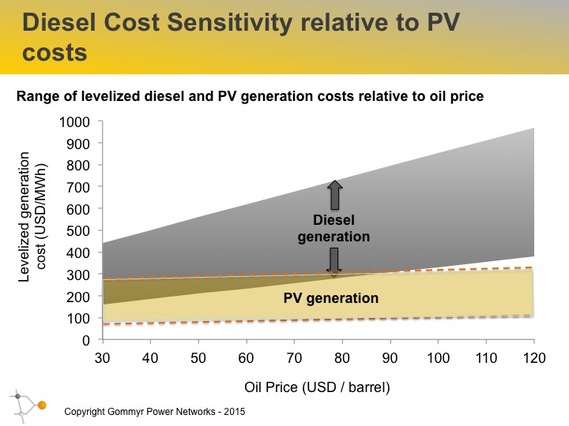
What Oil Prices mean for Microgrids in Numbers
The oil price is still making the news in 2015 – initially because of its continued drop in January, and most recently because of the steep increase from the earlier lows. This volatility makes forecasting, costing and planning for projects that are directly or indirectly linked to oil prices challenging. As renewable microgrids typically displace diesel-based generation, the oil price assumptions are critical for the economics of these projects. However, the relationship between oil prices and the levelized cost of diesel power generation (using levelized costs is important to have comparable expected lifetime costs of power generation across technology alternatives) is often not well understood. Diesel price assumptions are directly linked to oil price assumptions and are critical to the levelized generation costs over the project lifetime and therefore critical to the technology selection for projects. The picture for power users and microgrid owners is further blurred as diesel prices are typically also impacted by government and regulatory measures that either greatly increase (in the case of taxes) or decrease (in the case of state subsidies) the price to the diesel buyer. As stated in a previous blog post, the recent oil price drop may be beneficial for renewable projects to the degree that governments use the lower prices to reduce or eliminate subsidies for diesel.
In regards to diesel generation, in addition to the diesel price, many other factors will impact the levelized generation cost including load profile and generator efficiency, equipment costs and cost of capital, maintenance, staff and repair costs, and fuel storage costs. Similar factors must also be considered for assessing the levelized costs of alternative renewable technologies with which to compare (of course adjusted for the technology – for example using irradiation and temperature data instead of generator efficiency in the case of PV generation). In the following chart we have examined the sensitivity of the levelized cost of diesel generation to oil price (ignoring the market distortions of taxes or subsidies):

A few interesting points:
- Diesel generation costs can vary tremendously across the oil price range seen over the past year from <200 USD/MWh (0.20 USD/kWh) in the lowest cases to almost 1000 USD/MWH (1.00 USD/kWh) in the most expensive cases.
- The range in diesel generation costs increases as the oil price increases – this is due to the increasing impact of the generator efficiency relative to other costs as diesel costs increase.
We have also compared this range of diesel levelized costs with a typical range of levelized costs of generation from PV:

A few interesting points from this chart:
- PV generation is competitive with diesel generation across the range of oil prices and indeed diesel generation is only potentially competitive with PV generation with oil under 80 USD / barrel.
- PV generation is much less variable and volatile than diesel generation as oil prices have only secondary impacts on PV prices mainly through transport costs.
So why are more sites and projects not using PV instead of diesel? Currently there are three main reasons:
- Market understanding and acceptance of renewable technologies for distributed and microgrid applications is still at the early stage
- The variability, intermittency and reliability of renewable technologies have not yet been addressed in a simple and cost effective way (energy storage is the clear requirement)
- Financing – renewable technologies (and energy storage technologies) require most of the lifetime project costs upfront which means high capital requirements and higher risks for banks, financiers and investors vs. diesel generation in which most of the lifetime costs are ongoing fuel costs